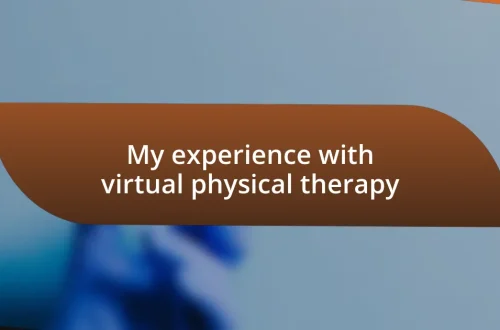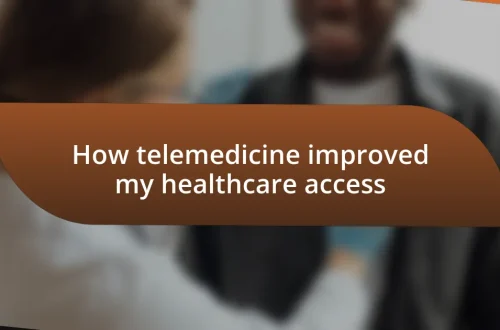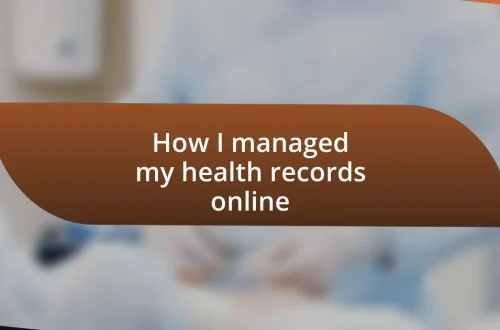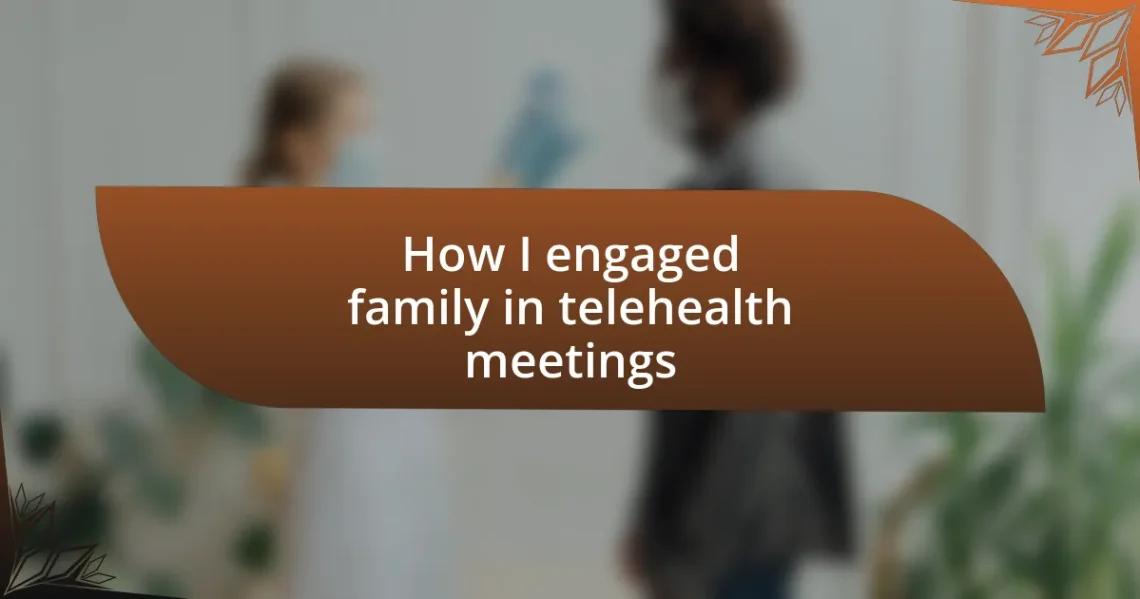
How I engaged family in telehealth meetings
Key takeaways:
- Telehealth meetings enhance inclusivity and family involvement, improving patient comfort and engagement in their care journeys.
- Family participation fosters a supportive environment, leading to better communication, understanding of treatment plans, and emotional support for patients.
- Selecting the right telehealth platform is critical; factors include usability, security, cost, and accessibility for both patients and family members.
- Effective communication and follow-ups after meetings strengthen understanding and connection among family members, ensuring all voices are heard.

Understanding Telehealth Meetings
Telehealth meetings have transformed the way we connect with healthcare providers, allowing patients and families to participate in discussions from the comfort of home. I remember the first time I logged on for a virtual appointment. My family was curious but hesitant; we all wondered, “Can this really be as effective as a face-to-face visit?”
As I sat there, it struck me how technology bridges gaps. I saw my grandmother’s eyes light up while speaking to her doctor via video. Suddenly, she felt more involved in her care journey than ever before. It made me realize that telehealth isn’t just about convenience; it represents a shift towards inclusivity in healthcare, where family involvement becomes more accessible.
Not all telehealth experiences are seamless, of course. I’ve faced technical glitches that momentarily halted our conversations, leading to that familiar frustration: “Did we lose the connection?” Nevertheless, these moments underline the importance of staying engaged and resilient, reminding us that with each click and connection, we are all part of a bigger healthcare dialogue.

Benefits of Family Engagement
Engaging family in telehealth meetings brings numerous advantages that enrich both the patient experience and care outcomes. From my perspective, one of the most compelling benefits is the supportive environment it fosters. When family members participate, I often see patients feeling more comfortable expressing their concerns and asking vital questions. There’s a palpable sense of reassurance when loved ones are present, creating a team atmosphere that truly enhances the consultation process.
- Increased emotional support for patients
- Improved communication regarding health concerns
- Enhanced understanding of treatment plans
- Greater accountability in following through with recommendations
- Opportunities for family members to ask questions that may arise during the meeting
Furthermore, involving family members can lead to a more comprehensive approach to care. I recall a telehealth session where my sister chimed in with questions about medication side effects that I didn’t even consider. Her perspective added layers to the conversation, illustrating how valuable diverse voices can be during medical discussions. Including family not only encourages a holistic understanding but also empowers everyone involved by ensuring that all voices are heard.
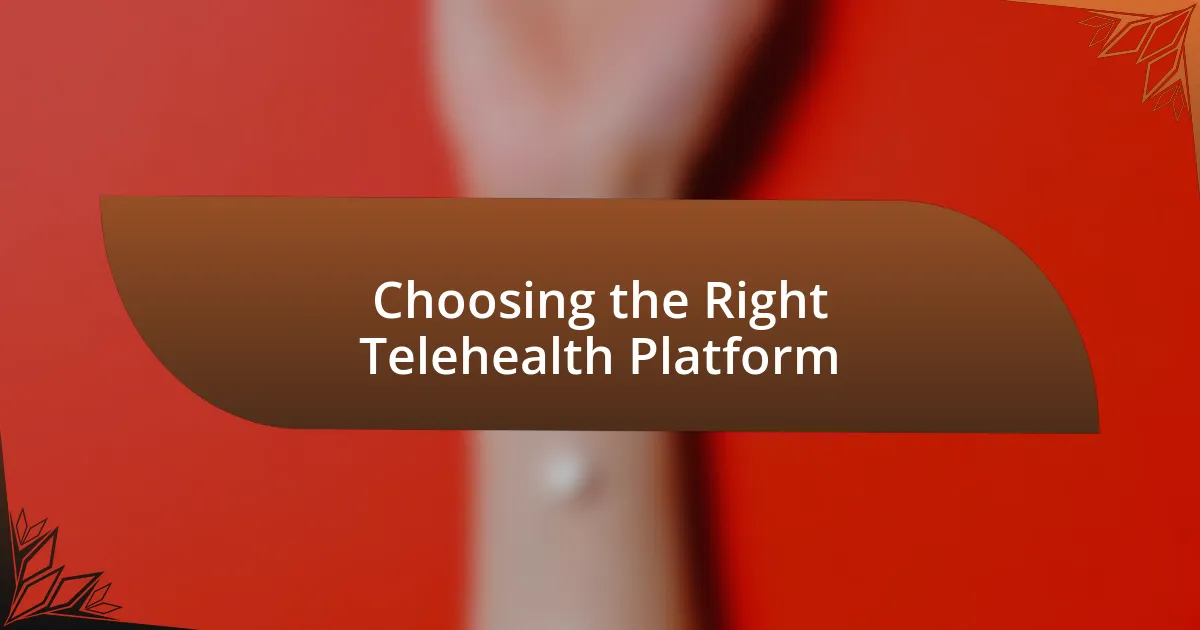
Choosing the Right Telehealth Platform
Choosing the Right Telehealth Platform
When selecting a telehealth platform, it’s vital to consider usability for both the patient and their family. From my experience, I’ve noticed that platforms offering intuitive interfaces significantly reduce the anxiety that often accompanies technology for those less familiar with it. For instance, I helped my elderly neighbor navigate a platform that was too complex; the frustration was palpable as she struggled with buttons that didn’t seem to make sense. In contrast, using a platform with a straightforward design made the experience smoother and helped her focus on what really mattered—her health.
Security features also play a crucial role in choosing a telehealth platform. I vividly remember attending a meeting where data confidentiality was a concern for a family member. Knowing that their sensitive information was adequately protected gave them peace of mind, allowing them to participate fully. This experience highlighted the importance of selecting a platform that prioritizes patient privacy through secure connections and encryption.
Cost and accessibility cannot be overlooked either. Many families are navigating tight budgets, so finding an affordable option that doesn’t compromise on quality can be a challenge. I recently assisted a friend who risked missing valuable telehealth sessions due to high costs. After researching, we found a platform that was not only budget-friendly but also provided features that closely matched their needs, leading to a remarkable improvement in their overall care experience.
| Platform | Key Features |
|---|---|
| Platform A | User-friendly interface, secure communication, mobile access |
| Platform B | Advanced security protocols, multi-party video, low-cost options |
| Platform C | Integrated patient management, insurance compatibility, virtual waiting room |

Preparing Your Family for Meetings
Preparing your family for telehealth meetings is all about setting the right expectations and providing a comfortable environment. I remember sitting down with my niece before her first appointment; I explained what to expect and eased her worries by sharing that it’s just like talking to a doctor in person, only through a screen. I felt a sense of relief wash over her as she realized it wasn’t as daunting as it seemed.
I’ve also found that technical preparations can make a world of difference. One time, I scheduled a practice run for our family, where we tested the video and audio settings a day before the actual appointment. It was really rewarding to see my brother, who usually shies away from technology, become more confident as he realized he could easily navigate the platform. Isn’t it amazing how just a little preparation can turn anxiety into assurance?
Moreover, creating a quiet, distraction-free space is crucial. The first time I held a telehealth meeting at home, my dog barking in the background became quite a comedic relief—until I realized it undermined the seriousness of the discussion. Since then, I always ensure that we pick a suitable spot and keep the area tidy and calm. Have you ever experienced interruptions during important conversations? It’s a reminder that we need to control our environment to ensure clear communication during these vital meetings.

Effective Communication Strategies
Effective communication in telehealth meetings goes beyond just words. I learned this firsthand when I made it a point to encourage my family members to speak up if they didn’t understand something. There was one instance where my mom hesitated to speak up, concerned she might interrupt the flow of the conversation. It hit me then how vital it is to foster an environment where everyone feels empowered to ask questions. Have you ever felt lost in a discussion but chose to stay silent? Creating a dialogue makes all the difference.
Facial expressions and body language take on new significance in a virtual setting. During one of our telehealth sessions, I noticed that my cousin was fidgeting, which indicated she was anxious about discussing her health. This prompted me to directly check in with her, allowing space for her to express her feelings. I believe that these moments of emotional connection are invaluable, especially when we’re all participating from our own homes. What tactics do you use to read non-verbal cues online?
Moreover, summarizing key points throughout the meeting can strengthen understanding. I found it helpful to recap what we discussed at various intervals, particularly after sharing important information. I did this during that pivotal appointment with my dad, emphasizing treatment options and next steps. Reflecting back not only reassured him but also ensured we were all on the same page. Isn’t it fascinating how taking a moment to clarify can lead to better outcomes for everyone involved?

Fostering a Supportive Environment
Creating a supportive environment during telehealth meetings involves actively inviting participation from everyone. I once organized a family health discussion where I asked each person to share their thoughts on the healthcare provider’s recommendations. This small gesture transformed our conversation, revealing diverse perspectives that enriched our understanding. Have you ever noticed how simply inviting everyone to share can shift the dynamics of a conversation?
I also find that acknowledging emotions plays a crucial role in fostering support. During one session, I sensed that my sister was holding back her feelings about her recent diagnosis. When I offered an empathetic ear and expressed my own concerns, it opened the floodgates. It reminded me that allowing vulnerability can strengthen our connections, especially in challenging times. How often do we underestimate the power of simply listening?
Lastly, I believe creating a physical space conducive to open dialogue can significantly impact our telehealth meetings. I made a point to set up a comfortable and inviting area for our discussions, using warm lighting and surrounding myself with personal items that brought me comfort. This little change helped everyone feel more relaxed and willing to engage. What environment do you create to help family feel at ease when discussing sensitive topics?

Following Up After Meetings
Following up after telehealth meetings is where I really see the benefits of our prior discussions. After one particularly intense meeting about my father’s treatment plan, I made it a point to check in with family members individually. A simple text asking how everyone was feeling not only showed that I cared but also opened the door for further dialogue. Have you found that these small gestures can create a sense of connection long after the meeting ends?
I also find that sharing notes or action steps from the meeting can be invaluable. For instance, I took the time to jot down key points and shared them in a family group chat. This not only helped everyone stay on the same page but also reinforced accountability for the decisions we made together. How often do we reflect on the importance of documenting those conversations to crystallize our collective understanding?
Sometimes, I bake a little treat or send a card as a follow-up to those meetings. After one telehealth session where we addressed multiple health concerns, I surprised my sister with homemade cookies. It was a small gesture that turned the focus from our worries back to the warmth of our family bond. Doesn’t it feel great to remind those you love that they are supported, even through tough discussions?


